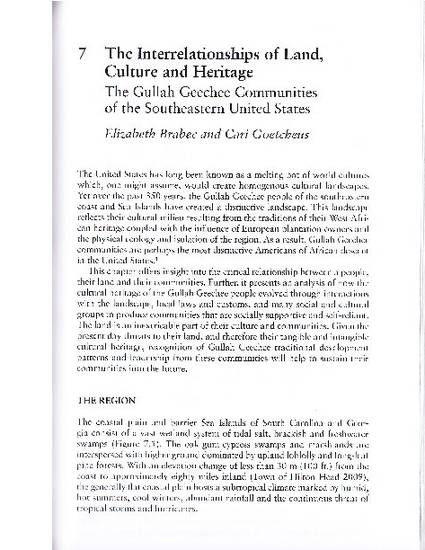
Contribution to Book
The Interrelationships of Land, Culture and Heritage: The Gullah Geechee Communities of the Southeastern United States
Conserving Cultural Landscapes: Challenges and new directions
(2015)
Abstract
The United States has long been known as a melting pot of world cultures which, one might assume, would create homogenous cultural landscapes. Yet over the past 350 years, the Gullah Geechee people of the southeastern coast and Sea Islands have created a distinctive landscape. This landscape reflects their cultural milieu resulting from the traditions of their West African heritage coupled with the influence of European plantation owners and the physical ecology and isolation of the region. As a result, Gullah Geechee communities are perhaps the most distinctive Americans of African descent in the United States.
This chapter offers insight into the critical relationship between a people, their land and their communities. Further, it presents an analysis of how the cultural heritage of the Gullah Geechee people evolved through interactions with the landscape, local laws and customs, and many social and cultural groups to produce communities that are socially supportive and self-reliant. The land is an inextricable part of their culture and communities. Given the present day threats to their land, and therefore their tangible and intangible cultural heritage, recognition of Gullah Geechee traditional development patterns and leadership from these communities will help to sustain their communities into the future.
Keywords
- Gullah,
- Gullah landscape,
- cultural landscape,
- Gullah heritage,
- Gullah Geechee
Disciplines
Publication Date
2015
Editor
Ken Taylor, Archer St. Clair and Nora J. Mitchell
Publisher
Routledge
Series
Routledge Studies in Heritage
ISBN
978-0-415-74405-8
Citation Information
Brabec, Elizabeth and Cari Goetcheus. 2015. "The Interrelationships of Land, Culture and Heritage: The Gullah Geechee Communities of the Southeastern United States." In Ken Taylor, Archer St. Clair and Nora J. Mitchell (eds), Conserving Cultural Landscapes: Challenges and new directions, p. 109 - 128.
Available at: http://works.bepress.com/elizabeth_brabec/58/
